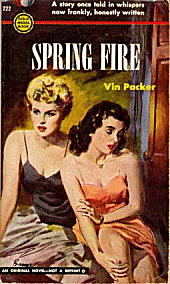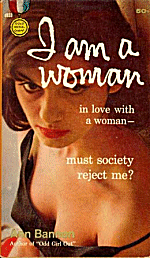| Pulp
Frisson: Sex Off the Rack The Lesbian at the Drugstore
by
William Dean
The
world’s first paperback book, perhaps fittingly, was Goethe’s Faust,
published in 1867. As you know, the story of Faust is about a bookish
man who sells his immortal soul for, among other things, a devilish and
sexy tryst with Helen of Troy, “history’s most beautiful woman.”
Obviously, this was not the paperback as we know it, but literally a cheaply
printed book in stiff paper wrappers instead of the usual leather binding
of that time. It was, however, indicative of the trend to come.
Faust
was a popular tale, with all the elements: sexy beautiful women, sinful
behavior, a comedic (if sardonic) sidekick to a powerful lead character,
and some sort of moral (or immoral) plotline. |

Lesbian
Pulp Fiction Paperback |
In 1935,
Penguin published the first paperback in a style more recognizable. In
fits and starts, popular literature began filtering out to the reading
public. The size, weight and shape had a lot going for it.
It could easily fit in a pocket or purse. People were traveling more,
by ship, train, and airplane, and the little paperback was the perfect
thing to entertain a reader’s mind as the miles passed beneath them.
The paperback grew immensely in popularity during World War II when GIs
and sailors carried them around and exchanged them to fill in the time
between jobs and combat.
Without
the cheaply produced paperback, it’s easy to speculate that a lot of fiction
would never have seen the light of day. But suddenly, something strange
was happening during the 1930s and ‘40s, which grew to become almost tradition
in the 1950s. Hand-in-hand with their sisters, the pulp magazines
of short stories, paperbacks began acquiring lurid, sexy cover art that
shouted and seduced from the racks in train and bus depots, airport terminal
stalls, and yes, even the corner drugstore in middle America. Something
was happening inside the covers, too. As genuine literature began
poking and probing behind the glossy scenes of everyday life, with such
salacious works as Erskine Caldwell’s Tobacco Road, so the publishers
and readers began saying “Hey! Give me more like that.” So was born
pulp novels that emphasized the sensual and illicit and even seedy underbelly
of life. Tobacco Road spawned “trashier” tales like Swamp Girl,
Baby
Doll, and The Shack.
 |
As
the straight heterosexuals bought up these sleazy tales for bedtime reading,
certain publishers with an eye on the marketplace started creating a venue
for books that dealt only with the sex, graphic sex, dirty words, people
actually fucking and sucking in descriptive purple prose. At first,
these were sold “under the counter.” There was no such beast as the
“adult bookstore” back then. Partly because American women had been
prominent in the workplace during World War II (but then unemployed when
the “boys came back home) and partly because naive American young men had
been thrust into the more permissive atmosphere of wartime Europe (but
then sent back to the farms, small towns and drudgery of nine to five jobs)
--- the thrilling, sexy, and edgy lives in paperback fiction created a
mass market. And publishers and writers rushed in the fill the gap
at pennies per word or less.
By
1950, a new breed of paperback appeared on the shelves of drugstores, where
most paperbacks were sold at the time. They featured similar highly
colored cover art, often featuring the same scantily clad women, but the
usual man figure was strikingly reduced in size or absent altogether. |
And one
woman seemed to dominate the other. So began the era of the lesbian
pulp novel. First Fawcett, with its Gold Medal series, then other
publishers joined in. Early genre or niche-marketing emerged with
formulaic plots that catered to those who preferred lesbians in prisons,
bisexual love triangles, lesbians redeemed by straight men, and lesbians
in criminal situations or military ones. The simple narrative storylines
and graphically portrayed sex appealed to straight readers, but they also
suddenly empowered and inspired a new generation of lesbian readers, who,
despite the warps and weaves of pornographic prose, found some of their
own lives, dilemmas, and pleasures in a work of popular fiction.
Academia
and the upper-class literary world, of course, had had its lesbian fiction
since even before Virginia Woolf and Radclyffe Hall, but now - with the
advent of the cheap paperback-- Rosie, the butch former-riveter, and Alice,
the lipstick femme waitress, could be found reading: tales of lesbian romance,
such as “I Am Woman,” by Ann Bannon:
"Come
here, Laura." She looked unearthly as she spoke, with her black hair tumbled,
her cheeks crimson. ...They stood motionless, so close that they touched.
...Laura shook all over. She couldn't talk except to repeat the other girl's
name over and over, as if she were in a trance...Neither of them heard
the phone ring, felt the chill of the rainy night, knew of anything except
each other.
Just
as with the “crime” and “noir” novels of Dashiel Hammet, Raymond Chandler,
and Jim Thompson, so the “happy homemaker” morality of Eisenhower era America
cast a certain Puritan pall over pulp fiction. Publishers felt justified
by the usual “unhappy ending” of most of the novels. The tales were
served up as a warning about the perils and pitfalls of the “unnatural”
sexual appetites of men and women; lesbians and gays. While Grace
Metalious’ Peyton Place sensationally ripped back the dirty sheets
that had made “Our Town” and “Spoon River” seem more innocent and benign,
two of today’s better known mainstream novelists were spinning lesbian
stories of lust, desire, and yes, even fulfillment. Marion Zimmer
Bradley, now known for her Mists of Avalon series, churned out the purple
pulps as Lee Chapman, Miriam Gardner, and Morgan Ives. Lawrence Block,
with his current prolific mysteries (starring Bernie Rhodenbarr, Tanner,
Matthew Scudder, and Keller), wrote under the pen names Jill Emerson, Sheldon
Ward, and Andrew Shaw.
The
early classics of lesbian pulp fiction appearing at the beginning of the
1950s are collectors items today, as much for their suggestive covers as
for the even more suggestive, even campy fiction between them. The
plotlines and blurbs are still inspiring to the salacious sisters-in-desire:
Leonard
Bishop’s Creep Into Thy Narrow Bed, published in 1954:
Adam
could survive the sadistic beatings, but he could not bear the thought
of what would happen to his inverted sister if he tried to escape the racket."
Adam recruits patients for an abortion racket, but agonizes most over his
'inverted' sister, Petey.
John
Evans’ Halo in Brass, published in 1950, combines two pulp worlds:
the lesbian and the detective. Private detective Paul Pine is hired by
an old Nebraskan couple to locate their daughter, but he suddenly finds
himself on a trail of murdered lesbians, including a few living as men.
Reed
Marr’s Women Without Men, published in 1957, tells the "true
story" about women in Kennetank prison. This is classic “women behind bars”
copy which starts with the evil “Queen” who’s cruelty and lust traps the
other hapless inmates until Mary shows up to take over the crown and control
of the prison-with gentler hands (and lips).
Tereska
Torrès’ Women's Barracks, published in 1950. The women
here are in the French army, and the book is their "true stories" as told
to the author. All the cliches of the genre are in this book, but especially
innocent girls preyed upon by experienced, hungry women.
Claire
Morgan, a pen name used by mystery author Patricia Highsmith, published
The
Price of Salt in 1953. Leaving the dull safety of the orphanage
to forge an acting career in New York, Therese has to settle for a job
in the toy department of a large department store. There, on the
opposite side of the counter, she meets Carol. After some obligatory and
flirtatious doll sales and a thank-you card, Therese ends up at the rich
older woman’s country house to find womanly desire, love, and, surprisingly,
happiness ever after.
|
By
the early to mid 1960s, pulp paperbacks were becoming more popular, lurid,
and available. The old titles from the ‘40s and ‘50s were still being
reprinted with new cover art and plenty of new novels were appearing, including
more lesbian books. I remember as a teenager, left on my own in Las
Vegas, trolling the large souvenir-slash-drugstores and buying (yes, I
looked old for my age) such books as Ann Bannon’s Beebo Brinker
and Paula Christian’s Another Kind of Love. Stashed among
the “candid” exposes of life in Hollywood or among the “beatnik generation,”
lesbian paperbacks were sold as commonly and openly as books on the mafia.
the high profile criminals of the 1930s and 1940s, and man-eating tigers
in India.
With
the sudden social trend of the hippies, in the mid and late ‘60s, however,
paperbacks began to feature “free love” (almost entirely heterosexual)
and “drug orgies. Along with the re-printing of “fantasy fiction”
like Lord of the Rings and science-fiction by Robert Heinlein, Ray Bradbury,
and Frank Herbert, the lurid, provocative lesbian books were pushed aside
in favor of “trippy” and outlandish books. |
They found
a new home, along with gay pulp, in the emergence of the “adult bookstore.”
About this time, too, Women’s Liberation and “feminist” activism began
to envelope many lesbians so that their time was spent reading (and writing!)
political tracts and sociological manifestoes.
Today,
the original lewd cover paperbacks-- the forerunners of today’s prominent
gay and lesbian erotica novels - are being eagerly collected by universities
as historic literary references. Their contents, however, are being
reborn in republished droves, for today’s less academic readers to marvel
at and enjoy. It’s good to know that what was once considered perverse
and “unnatural” is proving to be immortal, isn’t it?
Copyright
© 2002 - 2003 William Dean. All Rights Reserved. Do not copy or post
in whole or in part.
 |
William
Dean is an erotic
rambler, a media dude, and a graphic artist. He’s Associate Editor and
Graphics Artist for Clean
Sheets. He creates graphics and writes the monthly column "Into the
Erotik" for Erotica
Readers Association. Dean also hosts the column "Erotik Journeys" at
BackWash.com.
He's published in SoMa Literary Digest, Hoot Island, suspect
thoughts, Literotica, Other Rooms, and more. His short
stories have appeared in Desires, Tears on Black Roses, and
Clean
Sheets: From Porn to Poetry. He is a regular features contributor to
Mind Caviar.
Email William
Dean. |

Join
Adult
Friend Finder Free-- Meet Real Men & Women

|





